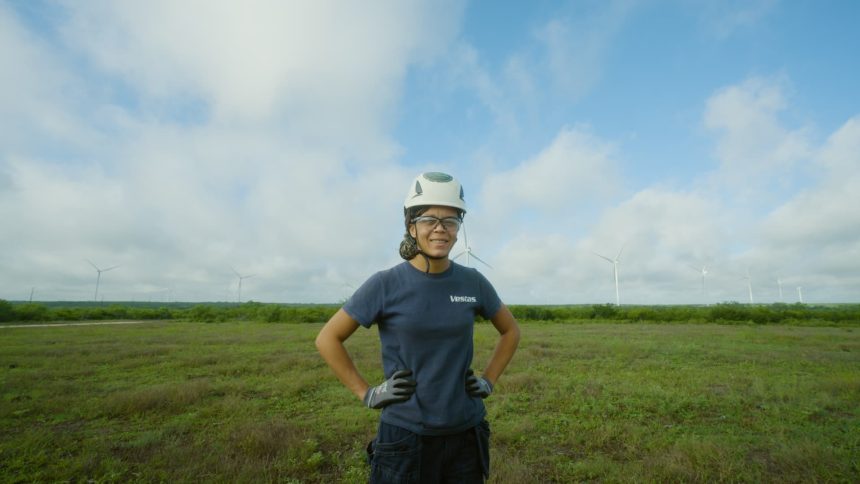Jessica Jackson was afraid of heights when she first started her job as a wind turbine service technician — now, she spends most of her days working 300 feet in the air.
Jackson, 37, is a technician at Vestas, a wind turbine manufacturer, in Bee County, Texas, and earns $73,000 per year.
Climbing the turbine tower “isn’t as scary as you’d think,” she tells CNBC Make It. The tallest turbine on the wind farm Jackson works on is about 350 feet above the ground. It takes her less than 10 minutes to get to the top.
“Once you’re up there, you get to see the best views: You’re watching birds fly, eagles, hawks,” she says. “You get to see planes fly by. You get to see as far as you can see. It’s beautiful.”
Jackson has one of the most dangerous jobs in the world. The Labor Department reports that wind turbine service technicians have one of the highest rates of injury and illness of all occupations.
It’s also the fastest-growing job in the U.S., with employment in the sector expected to almost double over the next decade.
“Working in this field is hard, but it’s rewarding,” says Jackson. “I love what I’m doing, so it makes the job not seem like a job as much.”
Here’s how Jackson earns $73,000 a year as a wind turbine service technician in Texas.
Getting the job
Before she became a wind tech, Jackson was a stay-at-home mom for 10 years.
After she and her husband separated in 2019, when her youngest child started school full time the following year, Jackson decided to return to the workforce. But she was worried her opportunities — and earning potential — would be limited without a bachelor’s degree.
She enrolled in college online part-time in 2017 but didn’t finish her bachelor’s degree in environmental science from the University of Arizona until 2022.
“Not having a college degree [yet] and being a single mom was hard,” says Jackson, who has four children between the ages of 10 and 21. “I was getting passed up for jobs that I had the experience and skills for only because I didn’t have that degree.”
Jackson’s ex-husband was working as a wind tech and recommended her for a job at Blattner Energy, a renewable energy contractor in northern Texas, installing tower wiring.
Jackson, 37, has been working as a wind turbine service technician for four and a half years.
Mickey Todiwala | CNBC Make It
While you don’t need a bachelor’s degree to become a wind turbine service technician, some jobs might require you to complete a 2-year technical program or apprenticeship. Others, like Blattner Energy and Vestas, will provide on-the-job training for new hires.
Vestas’ training covers best practices for the turbine’s electrical equipment, technical procedures like bolt torque and tensioning as well as first aid and safety protocols.
Jackson quickly fell in love with the hands-on aspects of servicing the turbines, the quiet peace of working in the wind.
“It felt good knowing that when a turbine was fixed or ran more smoothly, you did that, just seeing the immediate results of your efforts,” she says.
Working in a field that aims to help the environment was another perk that attracted her to the job.
“Wind turbines produce clean energy that goes to a grid, which then powers your homes, businesses, cell phones, TVs .. it’s awesome,” says Jackson. “I tell my kids all the time: Do something you love, but also do something that helps others and helps the environment.”
That job introduced Jackson to Vestas, where she started working in February 2020.
A day on the job
Jackson gets to work at 7 a.m. and ends her shift by 5:30 p.m. She works five days a week.
Every day on the job is different but starts with a problem.
“What I’m working on changes every day depending on what error code, or problem with the turbine, you’re coming in to,” Jackson explains. “The wind turbines are smart, they’re basically computers and constantly communicating to us what is going on with them.”
Vestas has 66 turbines on the farm where Jackson works. She’s typically responsible for one turbine per shift, but some days, it could be several.
Mickey Todiwala | CNBC Make It
Comparable to cars, wind turbines have sensitive electronic systems, generators, pumps and other critical components that are susceptible to freezing or breaking down. Jackson’s job is to inspect, maintain and repair such parts as needed to keep the turbines running and producing power.
Vestas has 66 turbines on the farm where Jackson works. She’s typically responsible for one turbine per shift, but some days, it could be several.
The hardest part of her job is the climb. Jackson has to scale a narrow, metal ladder inside the turbine and pull herself through a hatch at the top to access the turbine’s nacelle, which sits atop the tower and contains the machine’s main parts. It’s a vertical climb nearly 30 stories tall.
The largest wind turbine tower Jackson works on is about 344 feet high.
Mickey Todiwala | CNBC Make It
“Cutting any corners with safety could be the reason why I don’t go home that day,” says Jackson, who wears gloves, glasses, a helmet, harness and other protective equipment on the job. “Once you’re up there, you’re in your office and ready to work. Everything else is easier.”
She might have been scared of heights when she first started, but after practicing the same climb nearly every day, sometimes multiple times in the same afternoon, Jackson says she started to trust her equipment and “got a lot more comfortable climbing such high heights.”
‘If I was doing something else, I probably would not be as happy’
Jackson plans to work as a wind turbine service technician until she retires in her 70s, if not sooner.
The job might be physically demanding, but Jackson says spending so much time outside on the farm — and climbing the towers — has helped her feel “stronger and healthier.”
Jackson, pictured her with three of her children and her grandchild, says working as a wind technician has given her and her family financial stability and freedom.
Mickey Todiwala | CNBC Make It
She’s working toward getting promoted to a level-three technician at Vestas, a role that pays about $80,000 a year, then will train to become a lead technician after that, a role that pays about $100,000 a year.
“Having this job has given me financial stability and freedom, enabling me to afford activities that will make my children happy, like signing up for a basketball league, while still saving money every month,” she says.
As Jackson continues to climb the ranks in her career — both literally and figuratively — she hopes more women and non-degree holders will join her field.
“I’m extremely grateful for my job, I love what I do,” she adds. “If I was doing something else, I probably would not be as happy.”
Do you have a creative or nontraditional career path? We’d love to hear from you! Fill out this form to be considered for a future episode of “On the Job.”
DON’T MISS: Want to be smarter and more successful with your money, work & life? Sign up for our new newsletter!
Read the full article here




